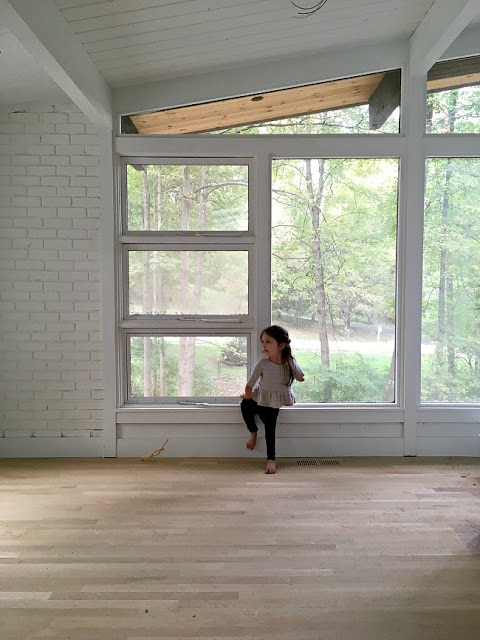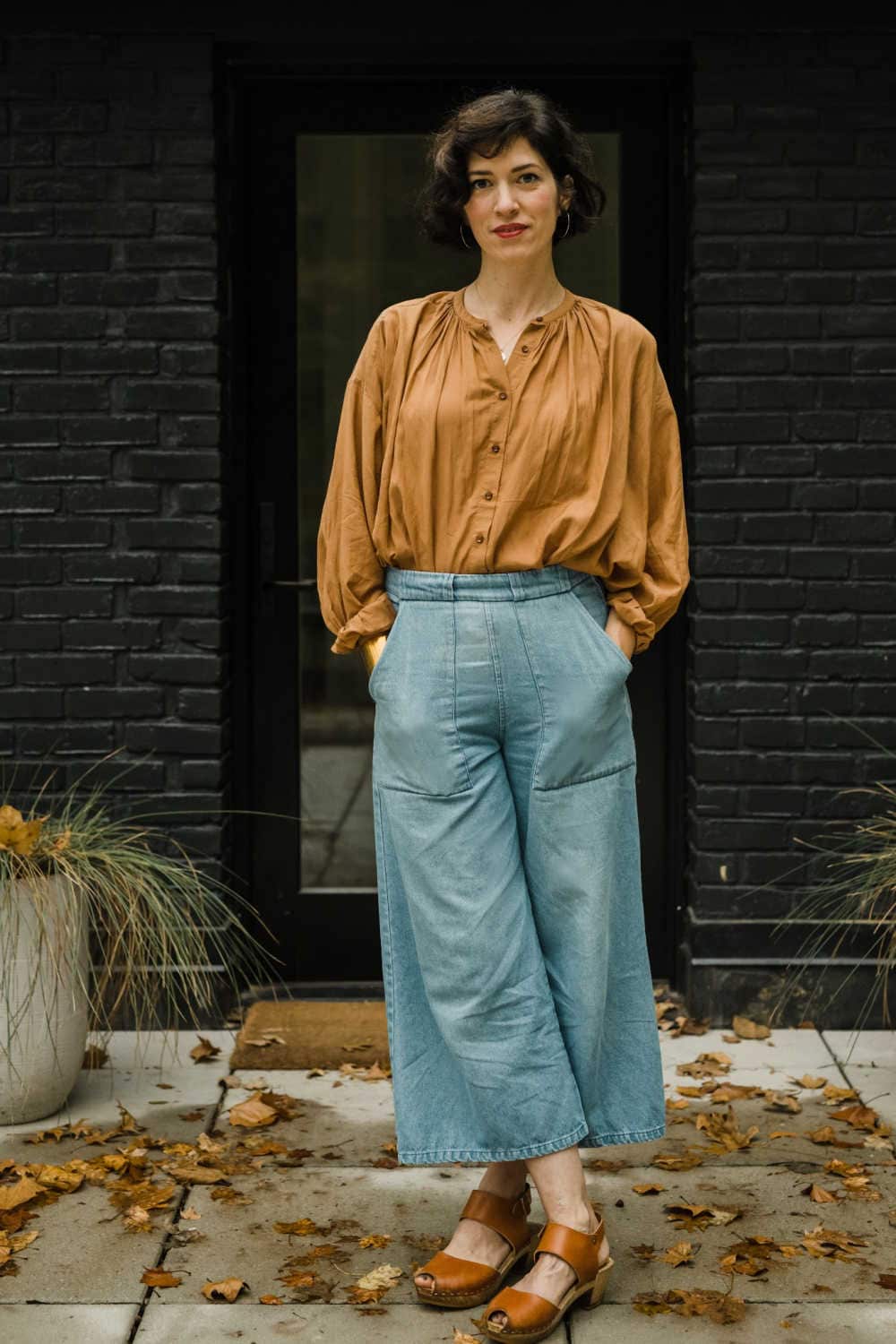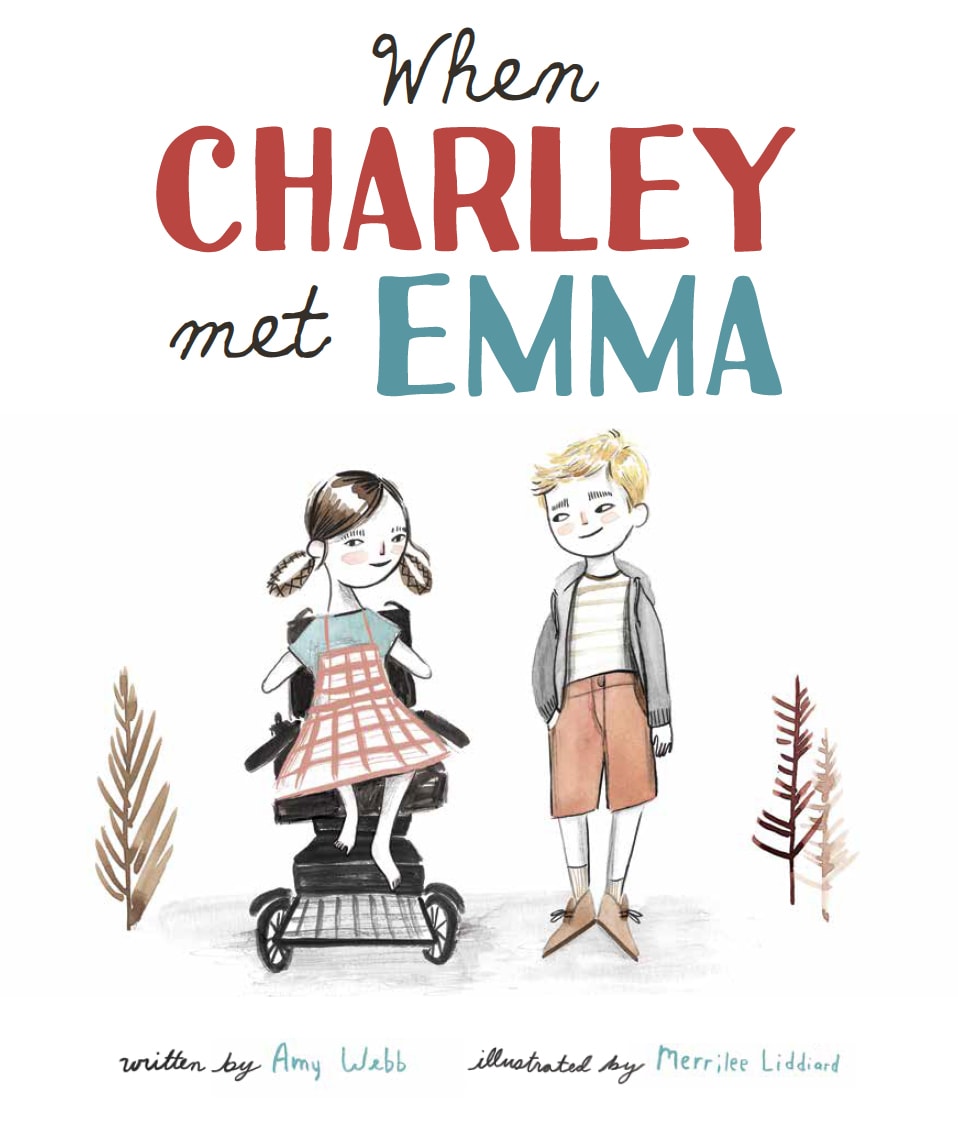We are renovating a 1961 mid century home and gutting it from top to bottom. In addition to be a dream house, it’s also going to be an accessible dream house. You can follow along from the beginning here and here with bathroom inspiration here and here, and kitchen inspiration here.
I snapped the above photo of Lamp the other day while checking out the house and I thought, We did this for you kiddo. We designed this whole house for you.
Which is true, and false and a grossly unfair statement to make all at the same time.
*****
In 1988 the National Multiple Sclerosis Society flew a man (whose identity I don’t know) out to New York City to receive their “Man of the Year” award. They put him up at the hotel across the street from where the gala was to take place. However, getting across the street to receive his award would prove to be a difficult task as the man drove an electric wheelchair. There were no curb cuts in the side walks back then, taxi’s could not accommodate his heavy, battery-operated chair and buses didn’t yet have wheelchair lifts. Eventually the MS society had to rent a van with a hydraulic lift simply to deliver this man across the street so he could receive his award.
Story paraphrased from the book No Pity: People with Disabilities Forging a New Civil Rights Movement by Joseph P. Shapiro
*****
What does it look like to design a house for a family of five, but with one person’s needs being the predominant driving force behind every decision?
Well it looks like tearing a wall down and rebuilding it 6 inches away. It looks like widening all the door ways and making sure there is a bathroom on both floors with a 5 foot turning radius to accommodate a wheelchair. It looks like a custom vanity in the bathroom and meeting after meeting after meeting on the kitchen island with contractors, designers and even the stone fabricators to make sure it is as functional as it is beautiful. It is concrete ramps and removing trees to grade the wooded lot so part of it is actually flat, a.k.a. accessible.
It is also looks like talking through with your husband over and over again about how a particular space might be used and navigated by this one family member. How is it navigated now? How will it be navigated in the future? Will she use her new chair, will she use her old chair, will this even matter? And of course it looks like talking with this family member herself. Because while she is only 8, she is also the world’s foremost expert on being herself.
It looks like a heart to heart with your contractor discussing the fact that while you’re sorry for second guessing everything and last minute decisions you’ve never done this before and you don’t know if you’re doing it right.
And of course it looks like a damn elevator smack dab in the middle of the house because we fancy like that.
*****
When Lamp was a baby–long before I the entirety of her needs would come into focus and long before a more developed understanding of disability and even longer still before I even thought about something as abstract to me as disability rights–I remember reading a story about a girl who was disabled, in fact I believe she had limb differences, and her parents fighting for her to be on her high schools cheerleading squad. I was the mother of a new baby girl with limb differences, but I had also been a high school cheerleader. Internally, I felt a sheepish guilt for having a daughter with special needs, but also believing these parents were off base. Cheerleading was a competitive sport at my high school with our varsity squad often taking 1st in State. Their stunts were amazing, as well as difficult and dangerous. At the very least, you needed long arms and hands to do cheerleading I thought. It’s just a requirement. It’s not personal. It’s the nature of the sport.
In their response to critics about their daughter lacking the basic requirements of what is needed in the sport of cheerleading (ie–arms and hands) the parents said (paraphrasing), “If we go by the current standards of what a person needs to participate, then she’ll never get to do anything.”
Holy $&#@.
They were right.
*****
The house we live in right now is approximately the 20th house (apartment, residence) I’ve lived in during my lifetime. This includes my childhood homes, my college years, where I moved often, post-college and our married life. For some that number sounds high, for others maybe it’s low. But the number isn’t really the point.
The point is, I lived comfortably in each and every place. Comfortably meaning I could get enter every single door without a problem. I could make due with even the tiniest of bathrooms, I could access every closet and cupboard at most needing a stepping stool from time to time. And I never once thought about stairs, whether there were a lot or a little they were all the same to me.
In fact in 2009 when we moved into our first home that also happened to be a 96 year old Victorian I felt so so lucky. I had always wanted a grand old home and this was it. From basement to the finished attic there were 4 full levels and I never gave the stairs a second thought. If anything I welcomed the opportunity to climb those Victorian era steps day and night. The first floor had a front and a back staircase that met at a veranda and I’ll be damned if I didn’t feel like the Unsinkable Molly Brown.
All my life houses were houses. Some were big, some were small, some were littered with charm and history, while others were plain beige boxes. But not one of those houses ever un-liveable for me. I could easily and comfortably live and move in them all.
That is not the case for Lamp. Big or small, lavish or plain, houses are anything but simple for us now.
*****
A few weeks ago PSP had a soccer game at an away field we had never been to before. We parked the van and Lamp exited out onto the grass by the fields. Just across the street was a playground, Lamp asked if she and Zuzu could go play until the game started. When I say it was across the street, it was really just across a small 2 lane road that went through this larger recreational area, so it wasn’t distant or dangerous to have let them go play. But there was a curb on both sides of the street and we had to find the curb cut before Lamp could cross. (Her chair weighs 330 pounds and therefore cannot be lifted over a curb.) We walked up and we walked down, there was no curb cut anywhere. The playground sat no more than 50 feet away and yet she couldn’t get there without loading her back in the van, and flipping a u-turn in the middle of the street to let her out on the other side. We didn’t have time and I told her lets just go watch the game. I can still see her in my mind, sitting in her chair feet away from a playground she couldn’t access.
Me thinks I should keep a sledge hammer in the car from now on.
*****
Some people will say (in fact have said), “You should be grateful you can afford to build this house, most people in your situation would not be able to afford this.”
A) I am aware and I am grateful.
B) Please keep in mind that my hard is not your hard. If your child breaks an arm and I say, “Well at least your kid has an arm!!!” That might be a valid point, but it doesn’t actually take away the pain and frustration the broken arm has caused your child. Even while my daughter doesn’t have an arm your child breaking an arm is HARD. Everyone lives within constraints–time, energy and money–and all of those have been maxed out for us on this home.
C) This is in fact part of the frustration and the fury that has been building over these past weeks and months. This process has been difficult and expensive and has made us so very aware of how hard it can be to make an existing structure work for a person who uses a wheelchair. There are charming buildings in our old town that my daughter literally can’t enter–unless we carry her and she scoots on the floor and that is not acceptable. Except that it is.
In the last few weeks as the house is really coming together it’s been a painful reminder just how inaccessible most spaces are for Lamp. Public spaces yes, but private spaces even more. Hearing from other disabled adults about how the lack of accessible homes–both for visiting and for living in themselves–puts considerable strain on their social life and their “just trying to live life” life. This lack of equality in one of our most basic human needs–shelter–feels a little soul crushing at times. Oh, the places she can’t go.
*****
Here’s the thing about curb cuts in sidewalks, yes they make it so people in wheelchairs and walkers can now cross the streets to accept awards, go to school, to work, and to play, but curb cuts also allow mothers pushing strollers to easily cross the street or delivery people with dollies filled to the brim to easily cross the street as well. When you make spaces accessible for the people with the least accessibility, these spaces will naturally work better for everyone. It’s not accessible design, it’s universal design.
This home is not for Lamp. It is for our entire family. But if it doesn’t work for Lamp, it doesn’t work for us. As difficult and emotional as the process has been at times it has also been exciting. I love this house and I love that I have had the opportunity to design a house for my family.
At this point my primary and main concern is, Did we get it right? Will this actually be functional for Lamp and therefore functional for our family as a whole? Because if we don’t have the proverbial curb cuts in our house not only is it frustrating for Lamp, it takes time and energy away from us as well.
My other children might read this post someday and feel vindicated, proof that Lamp’s needs were considered above their own, proof that the world, or at least our family, revolved around her. On the other hand Lamp might read this someday and feel a weight of guilt or resentment for once again bearing the weight of a lifetime of special consideration that she did not earn, strive for or feel worthy of, but was bestowed upon her nonetheless.
This is the conundrum of parenting a child with the kind of need that must be considered first and foremost, for all the big and many of the little life decisions in life. Homes. Cars. Vacations. Every one of these decisions must pass through the Lamp filter before we consider almost anyone or anything else.
But if we don’t consider her needs first, she would not get to do anything. And because we designed our home with the person who has the least mobility and accessibility in mind, we all get to do more.
As far as the house goes there is still SO MUCH TO DO, but we are also in the final stretch. Our current home is under contract (yay!) and our buyer occupancy date is less than 6 weeks away! Wha-what? We’ve had many time lines come and go, but now we are committed and I sure hope our contractor is as well.


.jpg)
.jpg)


I always appreciate how clear and thoughtful your posts are. Thank you for taking the time to do this blog. I have learned so much from you.
Thank you. Truly. THANK YOU. It has taken so much time over the years, and I absolutely love the work I do here, but it really helps to hear that someone else appreciates that work as well.
Thank you for posting this. I was just thinking about this yesterday when we had to "un-invite" ourselves from a family member's house because they told us their daughter was sick. When our daughter gets sick, she ends up in the hospital for a couple of days because of her metabolic disorder. So we made a change of plans, and it wasn't universally loved by our other children. It's hard and I don't have an answer for planning things for your family with an undercurrent of being aware of one person's needs more than the others. Thank you for trying to put words to this.
Yes, it is hard being caught in the middle. I understand where my other kids come from in their frustration sometimes, but I'll admit to not being patient other times. It has helped some to try and teach them that we strive for equity not equality.
As usual, beautifully put. Thank you Miggy, you always give me much food for thought, and a reminder to sometimes reshape my thinking.
Thanks Anon.
Um… regarding the cheerleading team, the pertinent question should be "Can she do the tasks required with reasonable accommodation?" not "Does she have arms?" If she can do the tasks required, whether she has arms or not shouldn't be an issue.
If she CAN'T do the tasks required… then demanding that the school give her a place on the squad because the poor little crippled girl deserves plums to make up for her crappy life strikes me as wrong and patronizing. The majority of girls in any high school aren't cheerleaders, so you can't say that it's an inclusion issue. Or claim that denying her a place on the squad means that "she can't do anything". There are a plethora of school activities she could take part in that AREN'T cheerleading. School newspaper. Prom committee. Yearbook staff. Student government. Drama Club. And many others I can't think of offhand.
Astrin–Well hello!
A) I love your passion. And point taken. We don't want the pity card for every little thing our sweet "crip" kids can't do.
B) This was something I read 8 years ago. The details escape me. This girl could have been more impaired to where she really couldn't or wouldn't be allowed to participate in other things–in which case their point stands. I *think* she might have had limb differences, but again I don't remember.
C) Again, having been on a squad not everyone is involved in a stunt and I think it is reasonable to make room for people of varying abilities in sports that haven't typically included them. Yes there are sports and teams for people with physical disabilities, but disabled kids want to participate on their school teams like their other classmates right? If we want the world to be more inclusive–jobs, housing, etc–and that takes some re-arranging and in some cases a complete overhaul of the status quo, than we should be expecting and preparing for some of that in our schools as well.
All for one, and one for all.
My youngest has Ds and a compromised immune system. I'm sure you can imagine the many scenarios that "limit" his siblings, who are just 7 and 5, especially during a Midwest fall/winter (I hear you, Michelle)!
In the past few months we've been dealing with some behavioral issues that I think stem from some the attention little brother gets. It's tough on them. My oldest seems to be needing A LOT more attention. It's been exhausting. I was lamenting/crying about this to my mother and she reminded me of what I have tried to say from the very beginning: it's not all about them. Or you or me, or my littlest. It's not all about any of us. I have friends (and even our pediatrician!) who talk about "fairness." As if "fairness" has anything to do with anything! That might sound cynical, but I really, truly don't mean it that way. There is so much joy to be found in putting others before ourselves, but doing so is not "fair" as we typically think of it.
Loving people is meeting them where they are. When we do our absolute best to accommodate others, in any life situation, but particularly for those who have little to no control over certain factors (like physical or cognitive disabilities) we all win.
That said, I see Astrin's point as well. One of my frustrations with the disability community is an insistence on what my son *can* do. Yes, in a million ways he is just like other kids, but in many ways he is not. There will be some things that he just can't do, and you know what? That is a-okay. He is still awesome.
Anyway, thank you for this post. I agree with Heather. You write so clearly and thoughtfully and graciously. I have learned so much coming here.
I overflow with admiration for you as you advocate for your children. If not their mothers, then who?!
God bless your family in your new home.